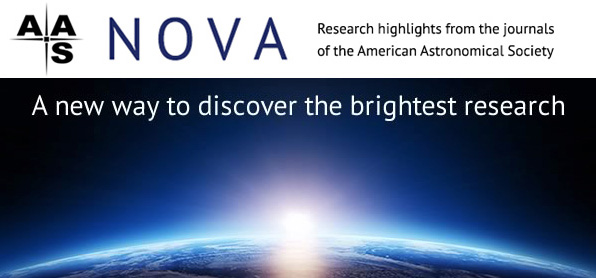Highlights from AAS Nova: 15 - 28 October 2017

Susanna Kohler American Astronomical Society (AAS)
AAS Nova provides brief highlights of recently published articles from the AAS journals, i.e., The Astronomical Journal (AJ) and The Astrophysical Journal (ApJ), ApJ Letters, and ApJ Supplements. The website's intent is to gain broader exposure for AAS authors and to provide astronomy researchers and enthusiasts with summaries of recent, interesting research across a wide range of astronomical fields.
The following are the AAS Nova highlights from the past two weeks; follow the links to read more, or visit the AAS Nova webpage for more posts.
27 October 2017
Observing a Strange Pulsar in X-ray and Radio
Astrobites reports on the unusually behaving pulsar PSR J1023+0038.
25 October 2017
Little Eyes on Large Solar Motions
It seems like science is increasingly being done with advanced detectors on enormous ground- and space-based telescopes. One might wonder: is there anything left to learn from observations made with small telescopes?
24 October 2017
A Neptune in the Nearby Hyades
Astrobites reports on a new Neptune-like planet discovered orbiting in a close binary system.
23 October 2017
How A Black Hole Lights Up Its Surroundings
How do the supermassive black holes that live at the centers of galaxies influence their environments?
20 October 2017
Trapping Dust to Form Planets
Growing a planet from a dust grain is hard work! A new study explores how vortices in protoplanetary disks can assist this process.
18 October 2017
Featured Image: Mixing Chemicals in Stars
How do stars mix chemicals in their interiors, leading to the abundances we measure at their surfaces?
17 October 2017
Is S0-2 a Binary Star?
The most exciting discoveries in astronomy all have something in common: they let us marvel at the fact that nature obeys laws of physics. Astrobites reports on the star S0-2, one of these exciting discoveries.
16 October 2017
Neutron-Star Merger Detected By Many Eyes and Ears
It’s rare that science progresses forward in a giant leap, with years of theories confirmed in one fell swoop. The simultaneous detection of a neutron-star merger in gravitational waves and photons marks one of these leaps.


